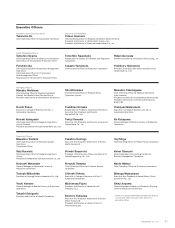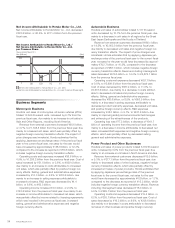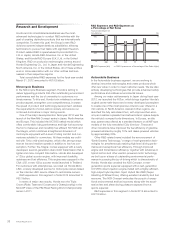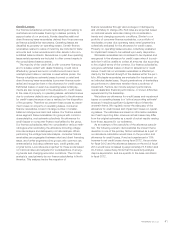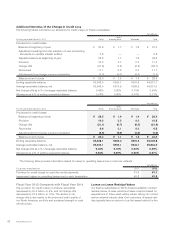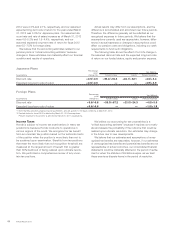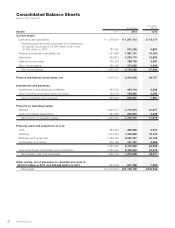Honda 2012 Annual Report Download - page 43
Download and view the complete annual report
Please find page 43 of the 2012 Honda annual report below. You can navigate through the pages in the report by either clicking on the pages listed below, or by using the keyword search tool below to find specific information within the annual report.Credit Losses
Our finance subsidiaries provide retail lending and leasing to
customers and wholesale financing to dealers primarily to
support sales of our products. Honda classifies retail and
direct financing lease receivables derived from those services
as finance subsidiaries-receivables. Operating leases are
classified as property on operating leases. Certain finance
receivables related to sales of inventory are included in trade
accounts and notes receivable and other assets in the con-
solidated balance sheets. Receivables on past due operating
lease rental payments are included in other current assets in
the consolidated balance sheets.
The majority of the credit risk is with consumer financing
and to a lesser extent with dealer financing. Credit risk is
affected by general economic conditions such as a rise in
unemployment rates or declines in used vehicle prices. Our
finance subsidiaries estimate losses incurred on retail and
direct financing lease receivables (consumer finance receiv-
ables) and recognize them in the allowance for credit losses.
Estimated losses on past due operating lease rental pay-
ments are also recognized in the allowance for credit losses.
In the case of property on operating leases, estimated losses
due to customer defaults are not recognized in the allowance
for credit losses because a loss is realized on the disposition
of the property. Therefore we present these losses as impair-
ment losses on property on operating leases. Consumer
finance receivables consist of a large number of smaller-
balance homogenous loans and leases. Our finance subsid-
iaries segment these receivables into groups with common
characteristics, and estimate collectively the allowance for
credit losses on consumer finance receivables by the group.
Our finance subsidiaries take into consideration various meth-
odologies when estimating the allowance including vintage
loss rate analysis and delinquency roll rate analysis. When
performing the vintage loss rate analysis, consumer finance
receivables are segregated between retail and direct financing
lease, and further segmented into groups with common risk
characteristics including collateral type, credit grades and
original terms. Loss rates are projected for these pools based
on historical rates and adjusted for considerations of emerg-
ing trends and changing economic conditions. The roll rate
analysis is used primarily by our finance subsidiaries in North
America. This analysis tracks the migration of
finance receivables through various stages of delinquency
and ultimately to charge-offs. Roll rates are projected based
on historical results while also taking into consideration
trends and changing economic conditions. Similar to our
portfolio of consumer finance receivables, our portfolio of
receivables on past due operating lease rental payments is
collectively evaluated for the allowance for credit losses.
Property on operating leases are also collectively evaluated
for impairment losses to be realized upon early disposition.
Wholesale receivables are considered to be impaired and
recognized in the allowance for credit losses when it is prob-
able that it will be unable to collect all amounts due according
to the original terms of the contract. Our finance subsidiaries
recognize estimated losses on them in allowance for credit
losses. Credit risk on wholesale receivables is affected pri-
marily by the financial strength of the dealers within the port-
folio. Wholesale receivables are evaluated for impairment on
an individual dealer basis. Ongoing evaluations of dealerships
are performed to determine whether there is evidence of
impairment. Factors can include payment performance,
overall dealership financial performance, or known difficulties
experienced by the dealership.
We believe our allowance for credit losses and impairment
losses on operating leases is a “critical accounting estimate”
because it requires significant judgment about inherently
uncertain items. We regularly review the adequacy of the
allowance for credit losses and impairment losses on operat-
ing leases. The estimates are based on information available
as of each reporting date. However actual losses may differ
from the original estimates as a result of actual results varying
from those assumed in our estimates.
As an example of the sensitivity of the allowance calcula-
tion, the following scenario demonstrates the impact that a
deviation in one of the primary factors estimated as a part of
our allowance calculation would have on the provision and
allowance for credit losses. If we had experienced a 10%
increase in net credit losses during fiscal 2012, the provision
for fiscal 2012 and the allowance balance at the end of fiscal
2012 would have increased by approximately ¥3.8 billion and
¥2.3 billion, respectively. Note that this sensitivity analysis
may be asymmetric, and are specific to the base conditions
in fiscal 2012.
Honda Motor Co., Ltd. 41


